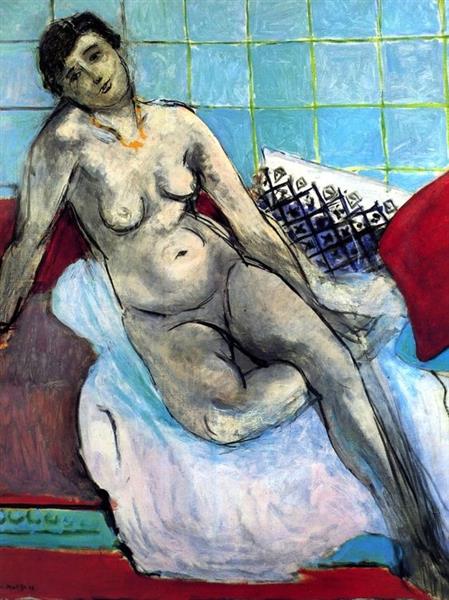Description
The painting "Grey Nude" by Henri Matisse, created in 1929, is a remarkable manifestation of the innovative approach and distinctive style that characterize the work of the renowned French painter. Henri Matisse, considered one of the most influential artists of the 20th century, is famous for his studies of color and form, elements that are prominently featured in this work.
"Grey Nude" depicts a reclining female figure, represented in a simplified, almost schematic manner, a characteristic that is emblematic of Matisse's work. The nudity of the figure is treated with an elegance and serenity that distances it from the vulgar, providing a sense of timelessness and calm. The model's posture, with its fluid forms and soft curves, suggests a meditative stillness, evoking the tranquility and peace of a private and contemplative moment.
The use of color in "Grey Nude" is particularly noteworthy. Matisse employs a limited palette, dominated by shades of gray and white, which can be interpreted as an exercise in chromatic abstraction and an interesting deviation from his usual tendency to use bold and vibrant colors. This chromatic choice further highlights the figure, which becomes the indisputable focus of the composition. The simplification of colors also directs our attention to the formal elements of the work: line and form.
Matisse's composition is both minimalist and deliberate. The figure is situated against a gray background that seems endless, which not only centralizes attention on the subject but also suggests an undefined space, imbued with a sense of eternity and universality. The lines that form the woman's body are precise and fluid, demonstrating Matisse's mastery in the economy of stroke and his ability to evoke volume and depth with the least amount of visual information.
One of the most fascinating aspects of "Grey Nude" is how Matisse manages to convey the essence of the human form with so few elements. The work reflects his approach to art as a process of reduction to the essential, eliminating superfluous details to capture the purity of visual perception. This simplification does not detract at all from the humanity and expressiveness of the portrait; rather, it intensifies it.
In the context of Matisse's artistic evolution, "Grey Nude" can be considered part of his continuous quest for purity and simplicity in art. Despite his initial fame as a leader of the Fauvist movement, known for its intensely vibrant colors, Matisse went on to explore a more serene and meditative style in his later years, which is reflected in works like this one.
The piece also stands out within Matisse's production of nudes, a recurring theme in his work. Unlike some of his other nudes, which are often set in lush and colorful environments, "Grey Nude" is distinguished by its austerity and monochromatic focus. This suggests an introspective phase in Matisse's production, in which the artist seems to have immersed himself in meditation on the human form and being in its most elemental state.
"Grey Nude" from 1929 is not just a study of the nude form, but also a profound exploration of the relationship between color, form, and perception. Henri Matisse, through this work, invites us to appreciate the simplicity and purity of artistic expression, showing us that even in the most severe reduction, sublime and moving beauty can be found.

